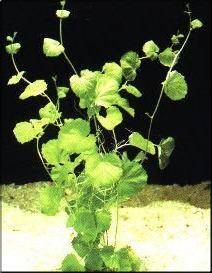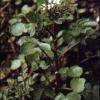Cardamine lyrata
Scientific name: Cardamine lyrata
Family: Brassicaceae
Maximum size reached under cultivation: 20 - 30 cm (7.87 - 11.81 inch)
014
Recommended pH range: 6 - 8
Recommended water hardness: 4 - 18°dGH (71.43 - 321.43ppm)
0°C 32°F30°C 86°F
Recommended temperature range: 15 - 24 °C (59 - 75.2°F)
Preferred propagation method: Cuttings
Native to: East Asia
Growth rate: Normal
Recommended substrate: Gravel
Lighting requirements: Bright
Ideal placement in tank: Background
🌿 Common Names
Japanese Cress, Chinese Ivy
🌍 Origin
Cardamine lyrata, commonly known as Japanese Cress or Chinese Ivy, originates from East Asia, specifically from the wetlands and marshy regions of China, Japan, and Korea. In its natural environment, it thrives in shallow, slow-moving waters where it grows both submerged and emersed. Its adaptability to different aquatic and semi-aquatic conditions makes it a favored plant among aquarium enthusiasts and paludarium hobbyists worldwide.
🌱 Propagation
Propagating Cardamine lyrata is simple and efficient, making it suitable for both beginners and experienced aquarists. Cuttings can be taken from any healthy part of the plant. Before planting, it is advisable to remove the lower leaves to expose a clean portion of the stem. Gently insert the cutting into the substrate without damaging the soft stem.
Additionally, the plant develops waterborne roots above the substrate. In some cases, cuttings can be floated at the tank surface to promote root development before planting. Although Cardamine lyrata is not a true floating species, this temporary method can create shaded areas beneficial for shy or light-sensitive fish.
💡 Lighting Requirements
Cardamine lyrata thrives under bright lighting. Adequate light prevents legginess, maintains compact growth, and encourages healthy leaf development. Insufficient lighting may cause the plant to stretch toward the surface and produce sparse, undersized leaves.
💧 Water Parameters
- Temperature: 15-24 °C (59-75 °F)
- pH: 6.0–8.0
- Water Hardness: Soft to moderately hard (up to 18 °dGH)
⚖️ Difficulty
Easy to Moderate. While generally hardy, Cardamine lyrata is sensitive to extreme temperatures, particularly sustained high heat, which can lead to legginess and leaf loss. Regular water condition monitoring, trimming of overly long stems, and avoiding overcrowding help maintain its attractive appearance and prevent competition for light.
🏡 Planting Area
Cardamine lyrata is best placed in the midground or background of the aquarium, depending on trimming and layout preferences. In paludariums, it can also be used along the waterline for a natural transition between water and land areas.
📝 Short Description
Cardamine lyrata is a highly adaptable aquatic plant, valued for its delicate, trailing leaves and soft, flowing growth pattern. When provided with bright light and suitable temperatures, it forms lush, bushy patches that add a naturalistic and calming element to aquascapes. Whether planted in clusters or allowed to trail and float temporarily, it enhances the visual depth and dynamic movement in both aquariums and paludariums. With proper care, Cardamine lyrata becomes a beautiful, resilient feature in any planted setup.

 Armoracia aquatica
Armoracia aquatica